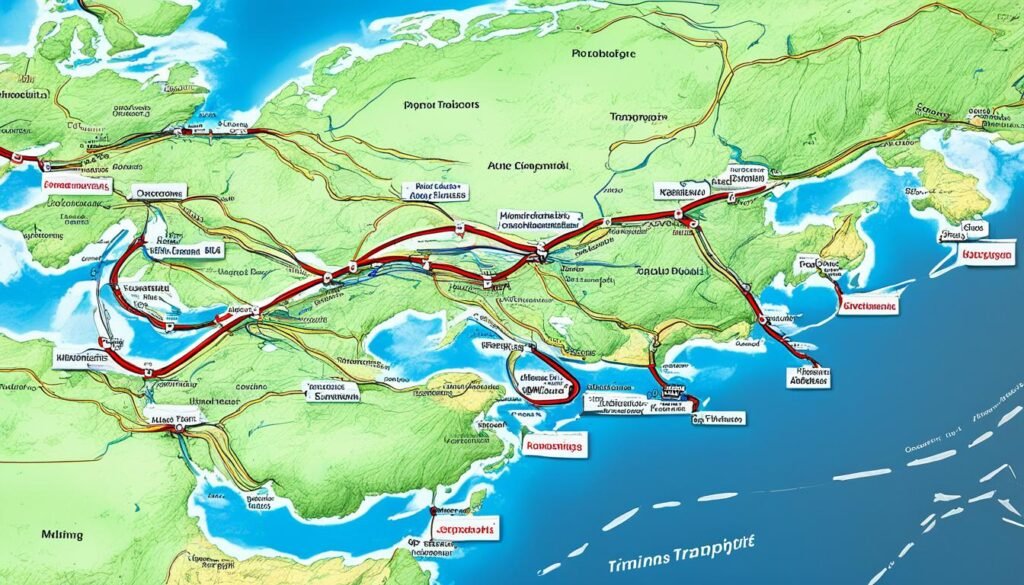Many people wonder how long auto transport takes. The time to ship your vehicle can change due to many factors. Let’s look at how long it usually takes and what changes this time.
Industry data shows average times change with distance. Expect 1-2 days for 0-200 miles. For over 2000 miles, it could take 7-9 days. Remember, these are just general ideas, and things can change.
Many things can change the transport time. These include where it’s picked up and dropped off, the season, and the weather. Road conditions, stops, and how long the driver can work also matter. So does how you choose to ship your vehicle. Cities are quicker to ship to than remote places. More time might be needed for hard-to-reach spots. Also, shipping can be slower if it’s busy season, there’s bad weather, or based on the vehicle type.
Key Takeaways:
- The average time for auto transport depends on the distance. It can be 1-2 days for short trips to 7-9 days for long ones.
- Many factors can change how long transport takes. These include pickup and drop-off spots, the season, and weather. Road conditions, extra stops, driver’s hours, and transportation methods are also important.
- Cities often have faster shipping times than remote places.
- Seasonal demand, bad weather, and the vehicle type can slow down shipping.
- Knowing these factors helps you plan and guess how long your vehicle’s transport will take.
Factors That Affect Auto Transport Time
Various factors affect how long auto transport takes. These factors can change your car’s shipping time. Consider these when planning:
1. Distance:
The pick-up and drop-off distance affects transport time. Longer distances take more time. See Table 1 for average times by mileage.
| Distance Range (in miles) | Average Transit Time |
|---|---|
| 0-500 | 1-2 days |
| 501-1000 | 2-3 days |
| 1000-1500 | 3-4 days |
| 1500-2000 | 5-6 days |
| 2000-2500 | 6-7 days |
| 2500-3000 | 7-8 days |
| 3000+ | 10-12 days |
Note: These are average times. They can change due to other factors.
2. Pick-up and Drop-off Locations:
Where your vehicle is picked up and delivered influences time. Cities are quicker due to better routes.
Rural areas may take longer due to the distance from highways.
3. Seasonal Variations:
Seasons also change transport time. May to September sees more demand. This can shorten transit times.
Winter or off-peak times may take longer due to fewer carriers.
4. Weather Conditions and Extra Stops:
Bad weather and extra stops can delay transport. Storms or snow can mean schedule changes.
Additional vehicle pickups or drop-offs can extend time, too.
5. Driver’s Hours and Transportation Method:
Driver’s hours and carrier type influence time. Federal rules limit driver hours, affecting schedules. Choose between open or enclosed carriers.
Open carriers are usually quicker.
Knowing these factors helps estimate your car’s transport time. This ensures smooth delivery.
How to Decrease Auto Transport Time
Needing to ship a car quickly is common. It might be for a move, a new purchase, or something else. To speed up car shipping, there are steps you can follow. These ensure your car gets shipped faster:
- Plan ahead: Book your car’s transport early. Try to do this about two weeks before you need it shipped. This gives enough time for planning and route setting.
- Research car shipping companies: Spend time looking into different shipping companies. Read what other customers say about them. Picking a good company means smoother and quicker shipping.
- Consider open car transport: Choosing open transport can make things faster. These carriers are more available, so it’s easier to schedule your car’s shipping.
- Explore additional options: If you’re in a rush, look at special options like guaranteed pickup. These choices cost more but speed up the process. They make sure your car is moved quickly.
By taking these steps, you can cut down on auto transport time. Faster car shipping saves time and gets your vehicle where it needs to be sooner.
Average Auto Transport Times for Different Distances
Planning to move your vehicle? Knowing the average transport times helps. These times show how long it might take to get your vehicle to its new place.
The average transit times for different distances are shown below:
| Distance Range (in miles) | Average Transit Time |
|---|---|
| 0-500 | 1-2 days |
| 501-1000 | 2-3 days |
| 1000-1500 | 3-4 days |
| 1500-2000 | 5-6 days |
| 2000-2500 | 6-7 days |
| 2500-3000 | 7-8 days |
| over 3000 | 10-12 days |
Remember, these times are just rough guesses. Things like weather and where you’re sending from and to can change them.
Factors Affecting Transport Time
What makes shipping times change? Distance, where you’re sending from and to, and other things matter.
Longer trips mean longer waiting. Being in or near big cities can speed things up. But, if you’re out in the country, it might take longer.
Weather, road conditions, extra stops, and your shipping method also play a part. These things can make it faster or slower to ship your vehicle.
Factors Affecting Car Shipping Time
Car shipping times can vary for many reasons. One main factor is where you’re sending the car from and to. City areas usually mean quicker shipping times. But, if it’s a rural place, it might take longer to get things moving.
How far and how popular the route is matters too. Longer trips and less common routes often take more time. This is because they need more planning. Also, what car you ship changes things. For example, motorcycles or luxury cars might need special carriers.
Choosing between open or closed transport affects timing. Open carriers are easier to find. So, they can be quicker. But, if your car needs to be extra safe, a closed carrier is better. This choice might slow things down, though.
The time of year and weather also change shipping times. Busy times, like summer, could mean faster shipping because there are more carriers. But, quieter times or bad weather might slow it down.
Factors Affecting Car Shipping Time:
- Pickup and drop-off locations (metropolitan vs. rural areas)
- Popularity and distance of the shipping route
- Type of vehicle being shipped
- Choice between open and enclosed transport
- Seasonal demand and weather conditions
Average Shipping Times for Different Routes (in Days)
| Route | Shipping Time |
|---|---|
| Northern Florida to Southern Tip | 1-3 days |
| New York to California | 8-12 days |
Tips to Expedite Auto Transport
Want to speed up the car shipping process? Here are some tips you can use:
- Book in advance: Book the auto transport company a few weeks before you need it. This gives you time to find the best carrier. Early booking helps speed up the shipping process.
- Choose open car transport: Using open car transport makes things faster. Open carriers are more common and can carry more cars. This means finding a carrier quickly and getting your vehicle sooner.
- Consider additional options: If you’re in a hurry, consider extra services like guaranteed pick-up or express shipping. These services cost more but make the process faster. They ensure your car is shipped quickly.
- Do thorough research: Spend time looking into car shipping companies. Compare their services, read customer reviews, and check their success. Picking a dependable company speeds up the shipping process.
Use these strategies to make car shipping faster. Book early, choose open transport, look at faster options, and do your homework. Doing these can help get your car where it needs to be quickly.
Average Car Shipping Times for Specific Routes
This info helps you know what to expect when shipping a car. Though these times are helpful, the real times may change due to different reasons.
If you’re sending a car from North Florida down south, it usually takes 1-3 days. But, sending a car from New York to California might take about 8-12 days.
These numbers are just general guesses for usual routes. Things like where you’re sending the car from and to can change these times. The distance, weather, and other things can also make a difference.
Knowing these average times helps you plan better when shipping a car.

How Pick-up and Drop-off Locations Affect Shipping Time
The pick-up and drop-off locations matter a lot for shipping times. Being close or far from city centers changes transit time. Places easy to get to usually mean faster shipping.
In big cities, sending and receiving things is quicker. Good roads and more carriers cut down on wait times. This makes the whole process smoother.
But in remote or hard-to-reach spots, shipping takes longer. Fewer carriers and tricky roads add to the delay. It takes more work to get things moving.
Thinking about shipping your car? Look at how easy it is to get to the pick-up and drop-off spots. Being near major roads helps. It can make shipping faster and less of a headache.
Factors to Consider:
- Accessibility and proximity to major highways and interstates;
- Availability of carriers in metropolitan vs. rural areas;
- Distance from well-established transportation routes;
- Coordination and planning required for hard-to-reach areas.
Keep these things in mind to get a good idea of shipping times. The start and end points affect how long it’ll take.
Benefits of Metropolitan Areas:
“Metropolitan areas offer quicker access, established transportation routes, and higher carrier availability, resulting in shorter shipping times.” – Car Shipping Experts
Seasonal Impact on Auto Transport Time
Seasons change how long it takes to ship a car. Some months see more people needing car shipping. This brings both good and tough spots for customers. Let’s dive into how seasons change auto transport times.
Peak Shipping Months: May to September
Car shipping gets busy from May to September. This is when many are moving, raising the need for these services. More trucks on the road mean cars get delivered faster. This is great for those needing quick vehicle delivery.
But, peak times also mean more people fighting for available trucks. Though cars may move faster, finding a truck can take longer. It’s smart to book your car’s shipment early during these busy months.
Winter Months and Less Busy Periods
Winter or slower times pose unique challenges. Fewer people ship cars, so there are fewer trucks available. This can make setting up your car’s pickup and drop-off slower.
Holidays and weather can also delay shipments in these months. It’s key to remember these extra factors when planning your shipment in the off-season.
How to Choose the Right Auto Transport Method
Choosing how to ship your car is a big decision. You can pick between open car carriers and enclosed carriers. Each has its benefits to think about for a wise choice.
Open Car Carriers
Most people ship their cars using open carriers. These are without roofs or sides and can carry many cars. It’s cheaper and quicker because these carriers are everywhere.
Enclosed Car Carriers
If you have a fancy or old car, you might prefer an enclosed carrier. These keep your car safe from road stuff and bad weather. But, they’re not as common, so it might take longer to arrange.
Think about what your car needs and how fast you need it moved. For regular cars, an open carrier works well and is fast. But, for special cars needing care, an enclosed carrier is safer.
Your choice depends on your money, how much your car is worth, and what you like. Look at these points to choose well and keep your car safe during its trip.

Steps in the Auto Transport Process
Shipping a car has many steps for a smooth and easy move. Knowing these steps helps you feel sure and understand timing better.
Start by picking a licensed and insured auto transport company. Do your homework and look at what customers say. This helps you find a good service. Then, get several quotes to see prices and what you get.
After choosing a company, you book the service. You’ll give details like where the car needs to go, about the car, and when. Being clear and exact here makes sure everything goes well.
With booking done, the transport starts. It’s key to keep up with any updates or changes. Talking well with the transport company keeps you in the loop. When the car gets there, you check it to make sure it’s as you left it. Lastly, you pay what’s left, and that’s it.
FAQ
How long does auto transport take?
Auto transport time varies. Factors like distance, location, season, weather, and road conditions matter.
What factors can affect auto transport time?
Several factors do. This includes locations, distance, route popularity, vehicle type, and method. Seasonal demand and weather also play a part.
Are there ways to decrease auto transport time?
Yes. You can plan ahead and book early. Choose open transport and express shipping for faster service.
What are the average auto transport times for different distances?
Here are the averages: 0-200 miles: 1-2 days. 200-600 miles: 2-4 days.
600-1000 miles: 3-5 days. 1000-1500 miles: 4-6 days.
1500-2000 miles: 5-7 days. Over 2000 miles: 6-9 days.
How do pick-up and drop-off locations affect car shipping time?
City locations usually mean quicker shipping. But rural areas might take longer. Major highways nearby help too.
What impact does the season have on auto transport time?
May to September is busy but fast due to high demand. Winter or less busy times might be slower.
How can I expedite the auto transport process?
Book early and pick open transport and express options. Research shipping companies for the best service.
What are the average car shipping times for specific routes?
From Northern Florida to the south takes 1-3 days. New York to California is about 8-12 days.
How does the location of pick-up and drop-off points affect shipping time?
Metro areas usually see faster service. Rural places take more time due to access and coordination.
How does the choice of transportation method affect shipping time?
Open carriers are quicker to book. Enclosed carriers, good for luxury cars, may need more scheduling time.
What are the steps involved in the auto transport process?
First, choose a licensed company and get quotes. Provide booking details and stay informed. Inspect on delivery and pay.

